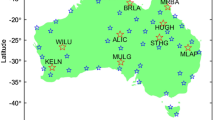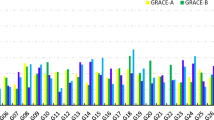Abstract
The ionospheric delay accounts for one of the major errors that the Global Navigation Satellite Systems (GNSS) suffer from. Hence, the global ionosphere Vertical Total Electron Content (VTEC) map has been an important atmospheric product within the International GNSS Service (IGS) since its early establishment. In this contribution, an enhanced method has been proposed for the modeling of the global VTECs, in which the enhancements include two aspects. Firstly, to cope with the rapid development of the newly established Galileo and BeiDou constellations in recent years, we extend the current dual-system (GPS/GLONASS) solution to a quad-system (GPS/GLONASS/Galileo/BeiDou) solution. More importantly, instead of using dual-frequency observations based on the Carrier-to-Code Leveling method, all available triple-frequency signals are utilized with a general raw-observation-based multi-frequency Precise Point Positioning model, which can process dual-, triple- or even arbitrary-frequency observations compatibly and flexibly. Benefiting from this, quad-system slant ionospheric delays can be retrieved based on multi-frequency observations in a more flexible, accurate and reliable way, which are finally used to establish global VTEC models with the spherical harmonic function. In this process, multi-GNSS Differential Code Biases (DCBs) are also estimated as by-products. More than 400 globally distributed stations from the IGS and the Multi-GNSS Experiment (MGEX) networks have been processed in both 2014 (with high solar activity) and 2018 (with low solar activity). Global VTECs have been compared with the IGS final products, and the over-ocean VTECs are validated with the results from the JASON altimeter. The mean RMS values of the VTEC differences are 1.84 (2014) and 1.23 (2018) TECUs with respect to the IGS final products. The standard deviations of the VTEC differences with respect to the JASON results are 4.71 (2014) and 2.82 (2018) TECUs, outperforming all the other products generated with the spherical harmonic function. Additionally, multi-GNSS satellite DCBs have also been validated with the existing products from the Center for Orbit Determination in Europe and MGEX. All the results prove that the proposed method can be used as an effective and accurate approach for global VTEC modeling and DCB estimation, especially in the future multi-frequency and multi-GNSS context.
















Similar content being viewed by others
Data availability
The multi-GNSS observation data from the IGS and MGEX networks are available at the FTP server cddis.gsfc.nasa.gov/pub/gps/data/. The multi-GNSS precise orbit and clock products from CODE are available at cddis.gsfc.nasa.gov/pub/gps/products/mgex/. CODE’s monthly mean DCB products can be found at ftp.aiub.unibe.ch//CODE/. The GIM products from different IACs can be obtained at cddis.gsfc.nasa.gov/pub/gps/products/ionex/. The multi-GNSS DCB products from CAS and DLR are available at cddis.gsfc.nasa.gov/pub/gps/products/mgex/dcb/.
References
Banville S, Collins P, Zhang W, Langley RB (2014) Global and regional ionospheric corrections for faster PPP convergence. Navigation 61:115–124
Chen Y, Yuan Y, Ding W, Zhang B, Liu T (2017) GLONASS pseudorange inter-channel biases considerations when jointly estimating GPS and GLONASS clock offset. GPS Solut 21(4):1525–1533
Ciraolo L, Azpilicueta F, Brunini C et al (2007) Calibration errors on experimental slant total electron content (TEC) determined with GPS. J Geod 81(2):111–120
Dach R, Lutz S, Walser P, Fridez P (2015) Bernese GNSS Software Version 5.2. Astronomical Institute, University of Bern, Switzerland
Feltens J (2003) The activities of the ionosphere working group of the International GPS Service (IGS). GPS Solut 7(1):41–46
Geng J, Bock Y (2013) Triple-frequency GPS precise point positioning with rapid ambiguity resolution. J Geod 87(5):449–460
Guo F, Li X, Zhang X et al (2017) Assessment of precise orbit and clock products for Galileo, BeiDou, and QZSS from IGS Multi-GNSS Experiment (MGEX). GPS Solut 21(1):279–290
Hernández-Pajares M, Juan J, Sanz J (1999) New approaches in global ionospheric determination using ground GPS data. J Atmos SolTerr Phys 61(16):1237–1247
Hernández-Pajares M, Juan JM, Sanz J et al (2009) The IGS VTEC maps: a reliable source of ionospheric information since 1998. J Geod 83(3–4):263–275
Hernández-Pajares M, Juan JM, Sanz J et al (2011) The ionosphere: effects, GPS modeling and the benefits for space geodetic techniques. J Geod 85(12):887–907
Hernández-Pajares M, Roma-Dollase D, Krankowski A, García-Rigo A, Orús-Pérez R (2017) Methodology and consistency of slant and vertical assessments for ionospheric electron content models. J Geod 91(12):1405–1414
Karatay S, Arikan F, Arikan O (2010) Investigation of total electron content variability due to seismic and geomagnetic disturbances in the ionosphere. Radio Sci 45(5):1–12
Klobuchar J (1987) Ionospheric time-delay algorithm for single-frequency GPS users. IEEE Trans Aerosp Electron Syst 23(3):325–331
Komjathy A (1997) Global ionospheric total electron content mapping using the Global Positioning System. Ph.D. thesis, University of New Brunswick, Canada
Komjathy A, Sparks L, Wilson BD, Mannucci AJ (2005) Automated daily processing of more than 1000 ground-based GPS receivers for studying intense ionospheric storms. Radio Sci 40(6):S6006
Lei J, Thayer JP, Forbes JM et al (2008) Ionosphere response to solar wind high-speed streams. Geophys Res Lett 35(19):141–149
Li Z, Yuan Y, Wang N et al (2015) SHPTS: towards a new method for generating precise global ionospheric TEC map based on spherical harmonic and generalized trigonometric series functions. J Geod 89(4):331–345
Li M, Yuan Y, Wang N et al (2018) Performance of various predicted GNSS global ionospheric maps relative to GPS and JASON TEC data. GPS Solut 22(2):55
Liu J, Chen R, Wang Z, Zhang H (2010) Spherical cap harmonic model for mapping and predicting regional TEC. GPS Solut 15(2):109–119
Liu T, Yuan Y, Zhang B et al (2017) Multi-GNSS Precise Point Positioning (MGPPP) using raw observations. J Geod 91(3):253–268
Liu T, Zhang B, Yuan Y, Li M (2018) Real-Time Precise Point Positioning (RTPPP) with raw observations and its application in real-time regional ionospheric VTEC modeling. J Geod 92(11):1267–1283
Liu T, Zhang B, Yuan Y et al (2019) Multi-GNSS triple-frequency differential code bias (DCB) determination with precise point positioning (PPP). J Geod 93(5):765–784
Mannucci A, Wilson B, Yuan D, Ho C, Lindqwister U, Runge T (1998) A global mapping technique for GPS-derived ionospheric total electron content measurements. Radio Sci 33(3):565–582
Montenbruck O, Steigenberger P, Khachikyan R et al (2014a) IGS-MGEX: preparing the ground for multi-constellation GNSS science. Inside GNSS 9(1):42–49
Montenbruck O, Hauschild A, Steigenberger P (2014b) Differential Code Bias estimation using multi-GNSS observations and global ionosphere maps. Navigation 61(3):191–201
Montenbruck O, Steigenberger P, Prange L et al (2017) The multi-GNSS experiment (MGEX) of the international GNSS service (IGS)—achievements, prospects and challenges. Adv Space Res 59(7):1671–1697
Odijk D (2002) Fast precise GPS positioning in the presence of ionospheric delays. Ph.D. thesis, Delft University of Technology, the Netherlands
Odijk D, Zhang B, Khodabandeh A et al (2016) On the estimability of parameters in undifferenced, uncombined GNSS network and PPP-RTK user models by means of S-system theory. J Geod 90(1):15–44
Orús R, Hernández-Pajares M, Juan J et al (2005) Improvement of global ionospheric VTEC maps by using kriging interpolation technique. J Atmos SolTerr Phys 67(16):1598–1609
Pan L, Zhang X, Guo F et al (2019) GPS inter-frequency clock bias estimation for both uncombined and ionospheric-free combined triple-frequency precise point positioning. J Geod 93(4):473–487
Prange L, Orliac E, Dach R et al (2017) CODE’s five-system orbit and clock solution—the challenges of multi-GNSS data analysis. J Geod 91(4):345–360
Roma-Dollase D, Hernández-Pajares M, Krankowski A et al (2018) Consistency of seven different GNSS global ionospheric mapping techniques during one solar cycle. J Geod 92(6):691–706
Schaer S (1999) Mapping and predicting the earth’s ionosphere using the global positioning system. Ph.D. Dissertation, University of Berne, Switzerland
Schaer S and Dach R (2010) Biases in GNSS Analysis. IGS Workshop 2010, Newcastle, England
Shi C, Gu S, Lou Y, Ge M (2012) An improved approach to model ionospheric delays for single-frequency precise point positioning. Adv Space Res 49(12):1698–1708
Sleewagen JM, Simsky A, de Wilde W et al (2012) Demystifying GLONASS inter-frequency carrier phase biases. Inside GNSS 7(3):57–61
Steigenberger P, Fritsche M, Dach R et al (2016) Estimation of satellite antenna phase center offsets for Galileo. J Geod 90(8):773–785
Strasser S, Mayer-Gürr T, Zehentner N (2019) Processing of GNSS constellations and ground station networks using the raw observation approach. J Geod 93(7):1045–1057
Wang N, Yuan Y, Li Z et al (2016) Determination of differential code biases with multi-GNSS observations. J Geod 90(3):209–228
Zhang B (2016) Three methods to retrieve slant total electron content measurements from ground-based GPS receivers and performance assessment. Radio Sci 51(7):972–988
Zhang B, Teunissen P, Yuan Y et al (2018) Joint estimation of vertical total electron content (VTEC) and satellite differential code biases (SDCBs) using low-cost receivers. J Geod 92(4):401–413
Zhang B, Chen Y, Yuan Y (2019) PPP-RTK based on undifferenced and uncombined observations: theoretical and practical aspects. J Geod 93(7):1011–1024
Zhao Q, Wang Y, Gu S et al (2019) Refining ionospheric delay modeling for undifferenced and uncombined GNSS data processing. J Geod 93(4):545–560
Acknowledgements
The authors would like to acknowledge the IGS, MGEX, CODE, DLR and CAS for providing access to global multi-GNSS observations, precise satellite orbit/clock and DCB products. JASON VTEC products from CNES are also gratefully acknowledged. The research is financed by China Natural Science Funds (Nos. 41804037 and 41674022) and National key Research Program of China “Collaborative Precision Positioning Project” (No. 2016YFB0501900). The second author is supported by the CAS Pioneer Hundred Talents Program. The third author acknowledges LU JIAXI International team program supported by the K.C. Wong Education Foundation and CAS.
Author information
Authors and Affiliations
Contributions
TL and BZ initiated the idea and designed the whole research; TL performed the research and wrote the paper; YY partially financed the research; XZ helped to accomplish some test and validation work.
Corresponding authors
Rights and permissions
About this article
Cite this article
Liu, T., Zhang, B., Yuan, Y. et al. On the application of the raw-observation-based PPP to global ionosphere VTEC modeling: an advantage demonstration in the multi-frequency and multi-GNSS context. J Geod 94, 1 (2020). https://doi.org/10.1007/s00190-019-01332-z
Received:
Accepted:
Published:
DOI: https://doi.org/10.1007/s00190-019-01332-z




